1995 PONTIAC BONNEVILLE light
[x] Cancel search: lightPage 6 of 338
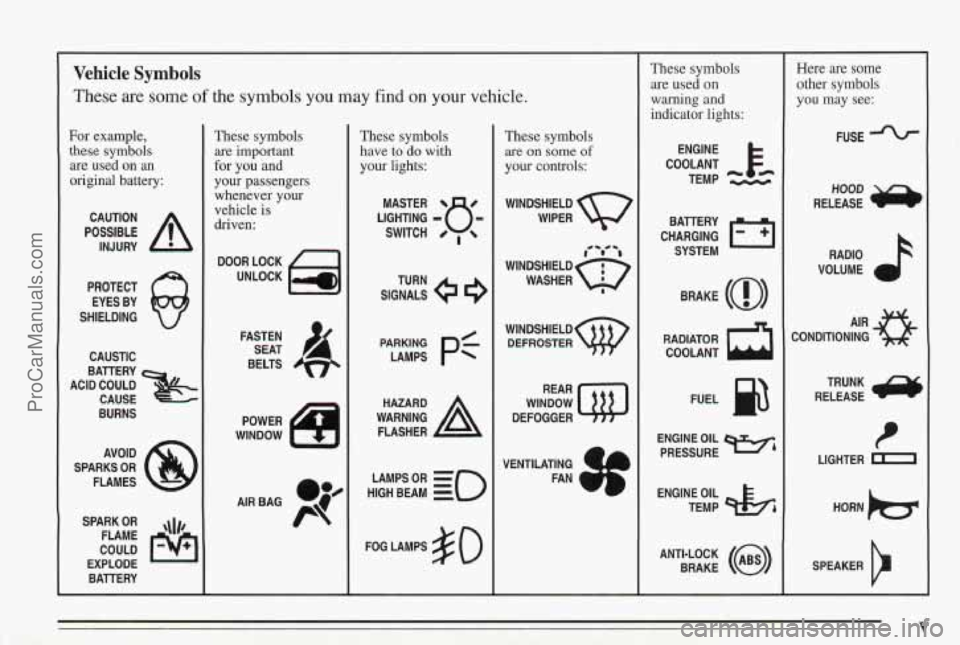
Vehicle Symbols
These are some of the symbols you may find on your vehicle.
For example,
these symbols
are used on
an
original battery:
POSSIBLE A
CAUTION
INJURY
PROTECT EYES BY
SHIELDING
CAUSTIC
ACID COULD BATTERY
CAUSE
BURNS
AVOID
SPARKS
OR
FLAMES
SPARK
OR ,\I/,
COULD FLAME
EXPLODE BAllERY
These symbols are
important
for you and
your passengers
whenever your
vehicle
is
driven:
DOOR LOCK
UNLOCK
FASTEN SEAT
4
BELTS
POWER
WINDNOW
These symbols
have
to do with
your lights:
SIGNALS 9
TURN
HIGH
LAMPSoR BEAM = =o
FOG LAMPS $0
These symbols
are on some of
your controls:
WIPER w
WINDsHIELDw DEFROSTER
WINDOW
DEFOGGER
VENTILATING
4 1
FAN CI
These symbols are used on
warning
and
indicator lights:
COOLANT Fe
TEMP --
ENGINE
CHARGING
I-1
BATTERY SYSTEM
BRAKE
(0)
RADIATOR COOLANT
a
FUEL @
ENGINE OIL
PRESSURE Wb
TEMP OIL 45
ANTI-LOCK (@)
BRAKE
Here are some
other symbols
you may see:
FUSE
RADIO
VOLUME
CONDITIONING
AIR 43
TRUNK
RELEASE
t
LIGHTER n
SPEAKER
V ProCarManuals.com
Page 12 of 338
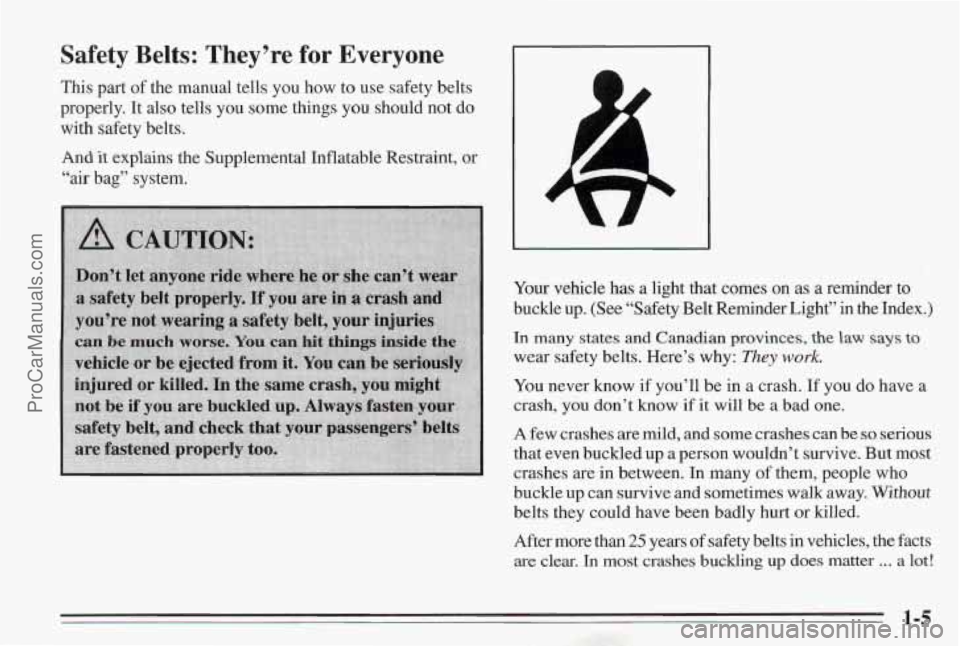
Safety Belts: They’re for Everyone
This part of the manual tells you how to use safety belts
properly. It also tells you some things you should not do
with safety belts.
And
it explains the Supplemental Inflatable Restraint, or
“air bag” system.
Your vehicle has a light that comes on as a reminder to
buckle
up. (See “Safety Belt Reminder Light’’ in the Index.)
In many states and Canadian provinces, the law says to
wear safety belts. Here’s why: They work.
You never know if you’ll be in a crash. If you do have a
crash, you don’t know
if it will be a bad one.
A few crashes are mild, and some crashes can be so serious
that even buckled up a person wouldn’t survive. But most
crashes are
in between. In many of them, people who
buckle up can survive and sometimes walk away.
Without
belts they could have been badly hurt or killed.
After more than
25 years of safety belts in vehicles, the facts
are clear. In most crashes buckling up does matter ... a lot!
1-5
ProCarManuals.com
Page 24 of 338
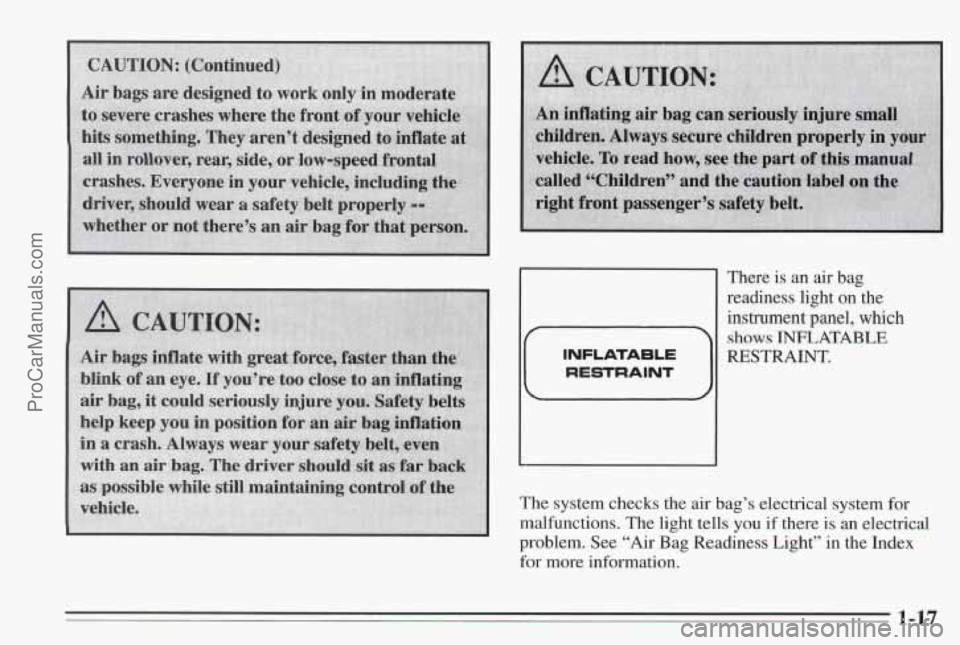
There is an air bag
readiness light
on the
instrument panel, which
shows INFLfXTABLE
RESTRAINT.
The system checks the air bag’s electrical system for
malfunctions. The light tells
you if there is an electrical
problem.
See “Air Bag Readiness Light” in the Index
for more information.
ProCarManuals.com
Page 57 of 338
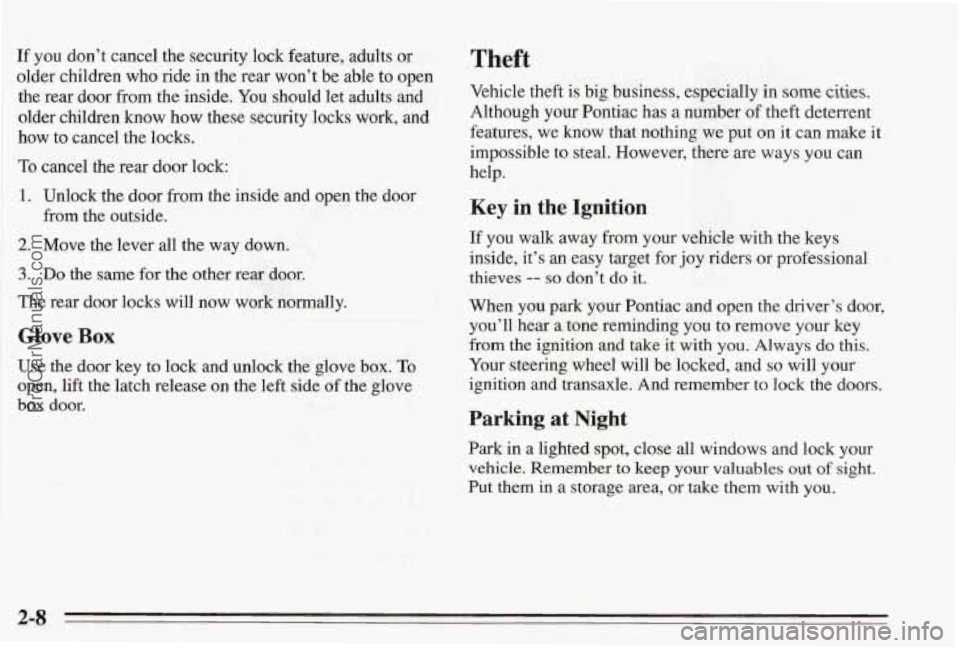
If you don’t cancel the security lock feature, adults or
older children who ride in the rear won’t be able to open
the rear door from the inside. You should let adults and
older children know
how these security locks work, and
how to cancel the locks.
To cancel the rear door lock:
1. Unlock the door from the inside and open the door
from the outside.
2. Move the lever all the way down.
3. Do the same for the other rear door.
The rear door locks will
now work normally.
Glove Box
Use the door key to lock and unlock the glove box. To
open, lift the latch release on the left side of the glove
box door.
Theft
Vehicle theft is big business, especially in some cities.
Although your Pontiac has a number of theft deterrent
features, we know that nothing we put on
it can make it
impossible to steal. However, there are ways
you can
help.
Key in the Ignition
If you walk away from your vehicle with the keys
inside, it’s an easy target for joy riders or professional
thieves
-- so don’t do it.
When you park your Pontiac and open the driver’s door,
you’ll hear
a tone reminding you to remove your key
from the ignition and
take it with you. Always do this.
Your steering wheel will be locked, and
so will your
ignition and transaxle. And remember
to lock the doors.
Parking at Night
Park in a lighted spot, close all windows and lock your
vehicle. Remember to keep your valuables out of sight.
Put them in a storage area, or take them with you.
2-8
ProCarManuals.com
Page 58 of 338
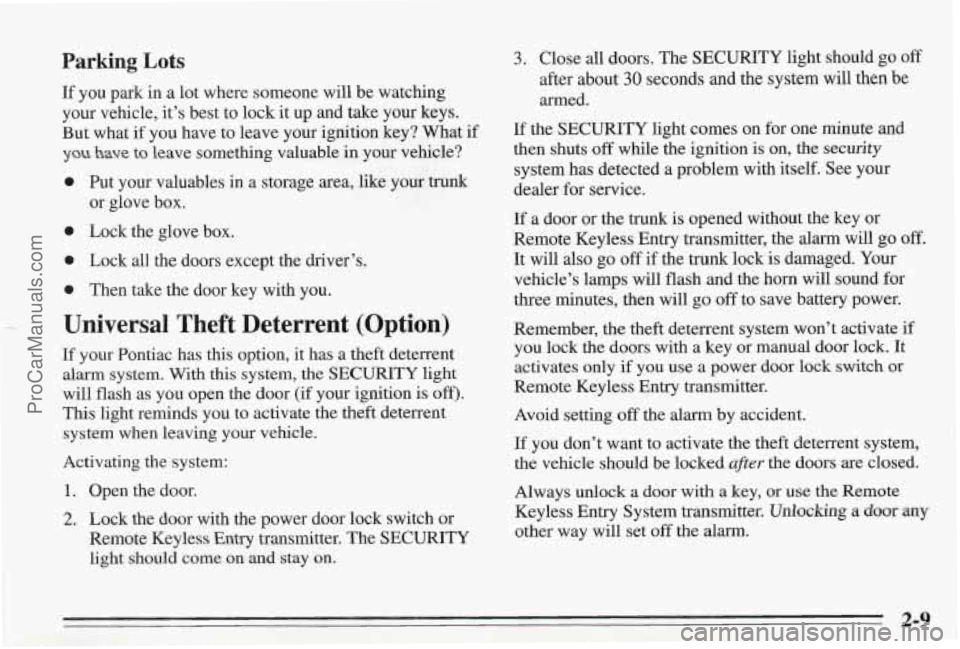
Parking Lots
If you park in a lot where someone will be watching
your vehicle, it’s best to lock it up and take your keys.
But what if you have to leave your ignition key? What if
you have to leave something valuable in your vehicle?
0
0
0
0
Put your valuables in a storage area, like your trunk
or glove box.
Lock the glove box.
Lock all the doors except the driver’s.
Then take the door key with you.
Universal Theft Deterrent (Option)
If your Pontiac has this option, it has a theft deterrent
alarm system. With this system, the
SECURITY light
will flash as you open the
door (if your ignition is off).
This light reminds you to activate the theft deterrent
system when leaving your vehicle.
Activating the system:
1. Open the door.
2. Lock the door with the power door lock switch or
Remote Keyless Entry transmitter. The SECURITY
light should
come on and stay on.
3. Close all doors. The SECURITY light should go off
after about 30 seconds and the system will then be
armed.
If the SECURITY light comes on for one minute and
then shuts
off while the ignition is on, the security
system has detected a problem with itself. See your
dealer for service.
If a door or the trunk is opened without the key or
Remote Keyless Entry transmitter, the alarm will
go off.
It will also go off if the trunk lock is damaged. Your
vehicle’s lamps will flash and the horn will sound for
three minutes, then will go
off to save battery power.
Remember, the theft deterrent system won’t activate
if
you lock the doors with a key or manual door lock. It
activates only if you
use a power door lock switch or
Remote Keyless Entry transmitter.
Avoid setting
off the alarm by accident.
If you don’t want to activate the theft deterrent system,
the vehicle should be locked
after the doors are closed.
Always unlock
a door with a key, or use the Remote
Keyless Entry System transmitter.
Unbckirrg a door my
other way will set off the alarm.
2-9
ProCarManuals.com
Page 60 of 338
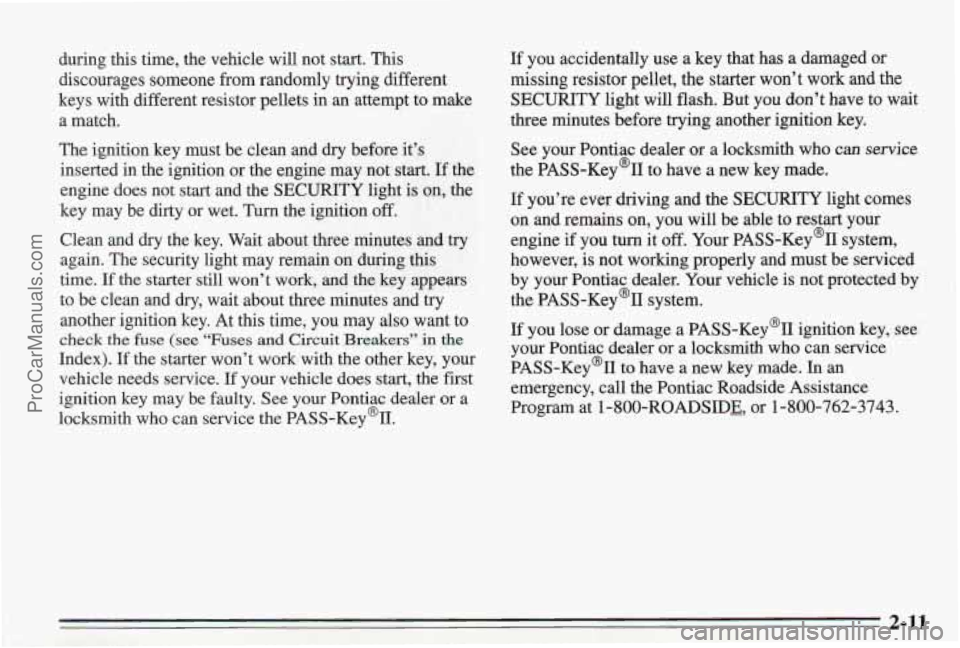
during this time, the vehicle will not start. This
discourages someone from randomly trying different
keys with different resistor pellets in an attempt to make
a match.
The ignition key must be clean and
dry before it’s
inserted in the ignition or the engine may not start. If the
engine does not start and the SECURITY light is on, the
key may be dirty or wet. Turn the ignition
off.
Clean and dry the key. Wait about three minutes and try
again. The security light may remain on during this
time. If the
starter still won’t work, and the key appears
to be clean and
dry, wait about three minutes and try
another ignition key. At this time, you may also want to
check the fuse (see “Fuses and Circuit Breakers” in the
Index). If the starter won’t work.with the other key, your
vehicle needs service. If your vehicle does start, the first
ignition key may be faulty.
See your Pontiac dealer or a
locksmith who can service the PASS-Key@II. If
you accidentally use a key that has
a damaged or
missing resistor pellet, the starter won’t work and the
SECURITY light will flash. But you don’t have to wait
three minutes before trying another ignition key.
See your Pontiac dealer or a locksmith who can service
the PASS-Key’II to have
a new key made.
If you’re
ever driving and the SECURITY light comes
on and remains on, you will be able to restart your
engine if you
turn it off. Your PASS-K~Y~I system,
however, is not working properly and must be serviced
by your Pontiac dealer. Your vehicle is not protected by
the PASS-Key% system.
If you lose or damage a PASS-Key(% ignition key, see
your Pontiac dealer or a locksmith who can service
PASS-Key@II to have a new key made. In an
emergency, call the Pontiac Roadside Assistance
Program at
1 -800-ROADSID& or 1-800-762-3743.
2-11
ProCarManuals.com
Page 63 of 338
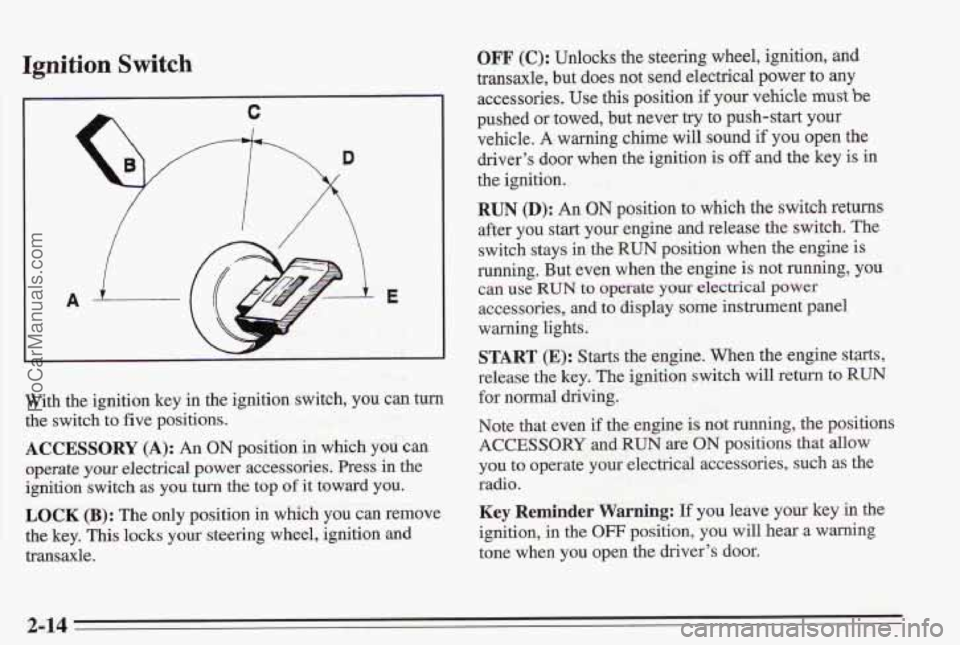
Ignition Switch
With the ignition key in the ignition switch, you can turn
the switch to five positions.
ACCESSORY (A): An ON position in which you can
operate your electrical power accessories. Press in the
igniti’on switch as you turn the top of it toward you.
LOCK (B): The only position in which you can remove
the key, This locks your steering wheel, ignition and
transaxle.
OFF (e): Unlocks the steering wheel, ignition, and
transaxle, but does not send electrical power to any
accessories.
Use this position if your vehicle me be
pushed or towed, but never try to push-start your
vehicle.
A warning cbime will sound if you open the
driver’s door when the ignition
is off and the key is in
the ignition.
RUN 0): An ON position to which the switch returns
after you start your engine and release the switch. The
switch stays in the RUN position when the engine is
running. But even when the engine is not running, you
accessories,
and to display some instrument panel
warning lights.
§TART (E): Starts the engine. When the engine starts,
release de key. The ignition switch will return to
RUN
for normal driving.
Note that even if
the engine is not running, the positions
ACCESSORY and RUN are ON positions that allow
you to operate
yom electrical accessories, such as the
radio.
Key Reminder Warning: If you leave your key in the
ignition, in the OFF position, you will hear a warning
tone when you open the driver’s door.
CEUl Use Rm to QPe3Tit.e yOlar &C!T’kd power
2-14 ProCarManuals.com
Page 66 of 338
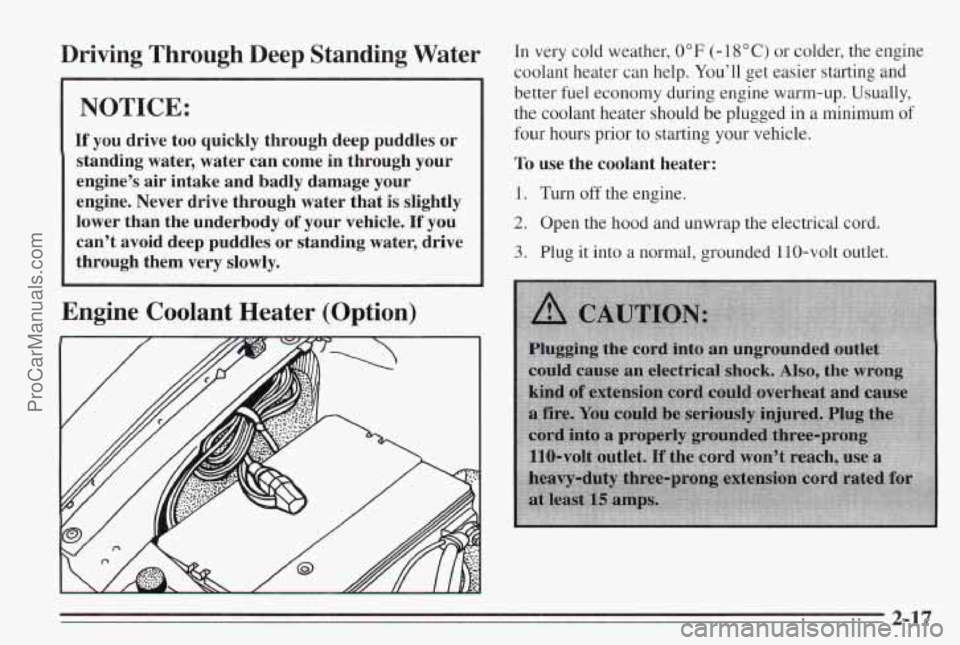
Driving Through Deep Standing Water
NOTICE:
If you drive too quickly through deep puddles or
standing water, water can come in through your
engine's air intake and badly damage your
engine. Never drive through water that is slightly
lower than the underbody
of your vehicle. If you
can't avoid deep puddles
or standing water, drive
through them very slowly.
Engine Coolant Heater (Option)
In very cold weather, 0°F (- 18 "C) or colder, the engine
coolant heater can help.
You'll get easier starting and
better fuel economy during engine warm-up.
Usually,
the coolant heater should be plugged in a minimum of
four hours prior
to starting your vehicle.
To use the coolant heater:
1. Turn off the engine.
2. Open the hood and unwrap the electrical cord.
3. Plug it into a normal, grounded 110-volt outlet.
2-17
ProCarManuals.com